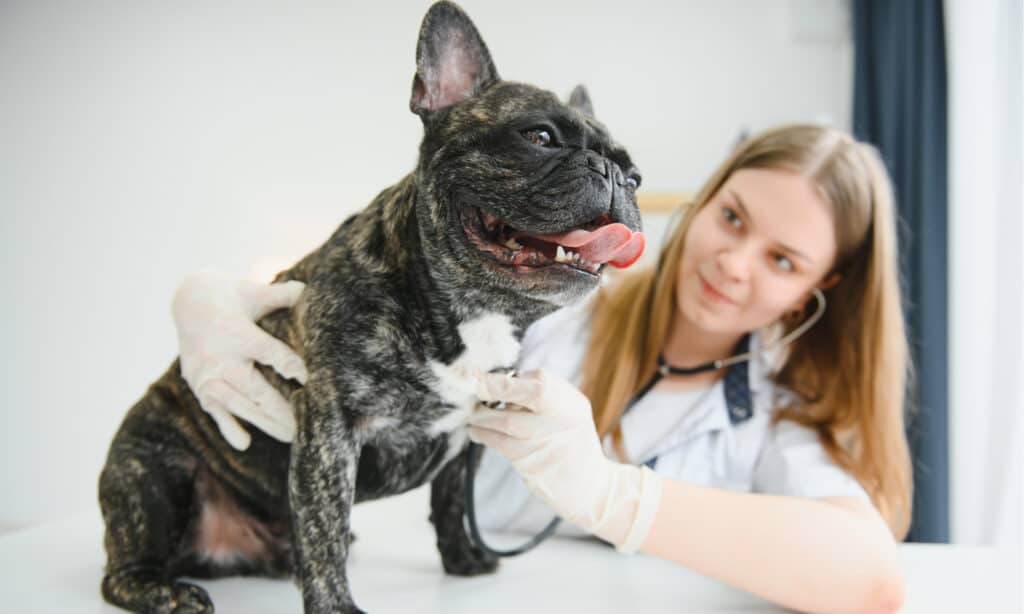As pet parents, we want to stay on top of our little one’s health. A variety of complications can threaten a dog’s wellbeing, and some of them are much scarier than others. One medical condition is always in the back of our minds when symptoms arise: Cancer. We do not suggest immediately assuming cancer is to blame anytime your dog is not feeling well. However, it is a medical threat that you should always be aware of. But what are dog cancers and symptoms? In this article, we discuss cancers and the more complicated symptoms that you should be on the lookout for. We also break down some of the more benign reasons why your dog may be feeling unwell.
Let’s dive into the types of cancer that can make your dog feel sick, as well as potential symptoms!
My Dog Is Not Feeling Well – Is It Cancer?

Though dogs can certainly develop cancer, there are other health complications that are much more likely to blame for your pet’s sudden illness.
©iStock.com/igorr1
We love our canine companions more than anything, so we can’t help but worry when they’re under the weather. Our minds often tend to jump to the worst-case scenario when we are deeply invested in anything, especially a loved one. This can cause many pet parents to worry about cancer when their dog is not feeling well.
Though our dogs can certainly develop cancer, there are many other health complications that are much more likely to develop. If your companion is feeling bad, she is very likely struggling with a benign health issue unrelated to cancer.
These common health complications include:
- GI upset due to consuming fatty food, exposure to bacteria, a change in diet, intestinal parasites, and even infectious illness
- Pain due to a soft tissue injury, joint disease, dental disease, ear infections, disc disease, or an upset stomach
- Skin discomfort due to fleas, ticks, skin allergies, skin mites, skin infections, and autoimmune conditions
- Urinary discomfort due to urinary tract infections, cystitis, bladder stones, or kidney disease
- Respiratory issues like coughing and sneezing due to infectious respiratory illness (kennel cough), allergies, heart disease, and lung disease
Though the health complications we listed above are not cancer related, they should still be taken seriously. The next time your beloved pet is not feeling well, aim to rule out these complications first. These issues are much more likely to develop than cancer.
How Common Is Cancer in Dogs?
As we discussed above, cancer is not the most likely factor behind your dog’s sudden illness. However, there are some canine friends that are more likely to develop cancer than others. To make sure you are aware of the potential threats, let’s go over some cancer statistics in dogs below!
Dogs can develop cancer at roughly the same rate as humans. One in four dogs will experience some form of cancer at some point in life. While any dog can fall victim to this disease, it is much more common in dogs over the age of 10. Unfortunately, about 50% of dogs over the age of 10 will develop some form of cancer.
A dog that is not spayed or neutered has a much higher risk of developing cancer as well. These pups can experience cancer involving their reproductive organs, while those that are sterilized will not.
Types Of Cancer in Dogs & Symptoms to Lookout For

About 50% of dogs over the age of 10 will develop some form of cancer.
©Hryshchyshen Serhii/Shutterstock.com
Lymphoma in Dogs
Lymphoma is the most commonly diagnosed cancer in dogs, as it makes up about 20% of all canine cancer cases. There are four types of lymphoma that are most commonly seen in our canines. They are divided based on the area of the body they affect. These include multicentric lymphoma (lymph nodes throughout the body), mediastinal lymphoma (lymph nodes in the chest cavity), alimentary lymphoma (lymph nodes in the GI tract), and extranodal lymphoma (skin, lungs, or kidneys).
Lymphoma symptoms in dogs will vary based on the form of lymphoma, but there are a list of common symptoms. Some of these include decreased appetite, weight loss, lethargy, enlarged lymph nodes, and chronic vomiting. Additionally, chronic diarrhea, chronic coughing, breathing changes, and a persistent fever of unknown origin are likely.
Osteosarcoma in Dogs
Osteosarcoma in dogs is a cancer that invades the bones. Though it can develop in any bone, it is most commonly found in the front and hind legs. Osteosarcoma is highly aggressive. It has often spread to other parts of the body by the time it is diagnosed. However, local tumor control is the best way to offer dogs the most time. Many vets will suggest amputating the leg that contains the tumor.
Symptoms of osteosarcoma in dogs will vary based on where it develops or how progressed it is. There are a few common signs to be on the lookout for, such as limping, complete lameness, and swelling. Additionally, lethargy, weight loss, and breathing changes are common.
Mast Cell Tumors in Dogs
Mast cell tumors are one of the most common forms of skin cancer in dogs. It is also known for being the most dangerous. A mast cell tumor is made up of mast cells, which play a major role in the body’s immune response. If the tumor is manipulated or irritated in any way, it can release a dangerous amount of histamine that triggers an anaphylactic reaction. In addition to this risk, the cancer itself is highly invasive.
Mast cell tumors can range in appearance, but there are a few common symptoms. These include a hard lump underneath the skin, an ulcerated lump on the skin, a sudden lump that appears to develop out of nowhere, and a lump that appears very irritated or swollen.
Mammary Tumors in Dogs
Mammary tumors are unfortunately very common in intact female dogs, and about 50% of them are a malignant cancer. This cancer impacts the dog’s mammary glands, but it can spread to other regions of the body as well. Carcinomas are the most common form of mammary cancer seen in dogs, but other forms are responsible in rare cases. While mammary cancer can technically develop in any female dog, it is believed to be a result of exposure to certain hormones that are present when the female dog is not spayed.
The most common sign of mammary cancer is one or more masses on the chest and around the nipples. These masses may appear as hard lumps underneath the surface of the skin. They can also spread to the surface of the skin as well. These masses can be irritated or ulcerated, and some will even ooze with discharge. Many of these tumors will also be extremely painful when they are touched, and they often become infected.
Hemangiosarcoma in Dogs
Hemangiosarcoma is a type of cancer that originates from the blood vessels. It can form anywhere in the body where blood vessels are located, but it is most commonly found in the spleen, heart, liver, and skin. The cancer highly invasive and dangerous. It also comes with additional risks due to it being tied up in the dog’s blood vessels. These tumors are known to bleed as they progress, with some dogs developing life threatening anemia as a result.
Symptoms will vary based on the part of the body affected. Some common symptoms include lethargy, weakness, decreased appetite, abdomen distention, changes in breathing, pale gums, or a mass on the surface of the skin.
Soft Tissue Sarcomas in Dogs
Soft tissue sarcomas in dogs are a form of cancer that involve the connective tissues. This cancer will often appear as a firm lump that sits just underneath the surface of the skin. It typically has long branches that connect the tumor to the surrounding tissues. This cancer can be anywhere on the body, but it is most commonly seen on the legs, chest, and abdomen.
The most common signs of a soft tissue sarcoma in dogs is a lump underneath the dog’s skin. They are not often painful, but this does not mean you should ignore them. They may not be uncomfortable for the dog in most cases, but they are known for being highly invasive.
I Think My Dog Has Cancer – What Should I Do?
If you think your dog has cancer for any reason, then we always suggest having them assessed by your trusted veterinarian. Not only are there many forms of cancer that our dogs can experience, there are also other health complications that can mimic the signs of cancer in dogs. You never want to assume that your dog has cancer until they have been thoroughly assessed by your veterinary team. It is very possible that your dog has a treatable illness of some kind.
If your vet believes that your pet could have cancer, then they will suggest the appropriate testing for official diagnosis. They may suggest performing blood tests, radiographs, and even tissue biopsies based on the symptoms your pup is experiencing. No matter your dog’s situation, we always suggest trusting your vet’s guidance each step of the way.
The photo featured at the top of this post is © F Armstrong Photography/Shutterstock.com
Ready to discover the top 10 cutest dog breeds in the entire world?
How about the fastest dogs, the largest dogs and those that are -- quite frankly -- just the kindest dogs on the planet? Each day, AZ Animals sends out lists just like this to our thousands of email subscribers. And the best part? It's FREE. Join today by entering your email below.
Thank you for reading! Have some feedback for us? Contact the AZ Animals editorial team.






